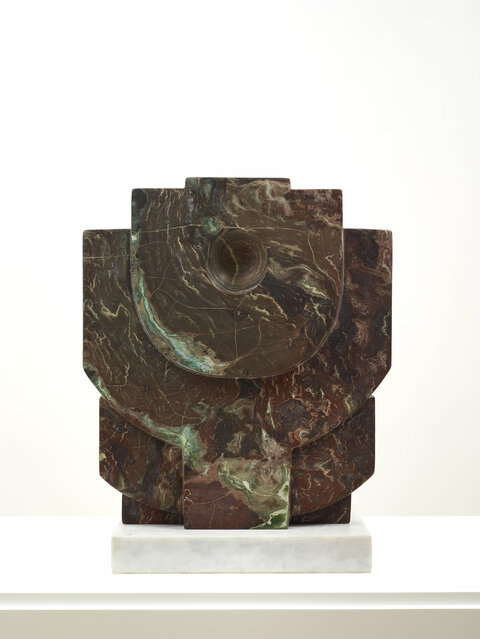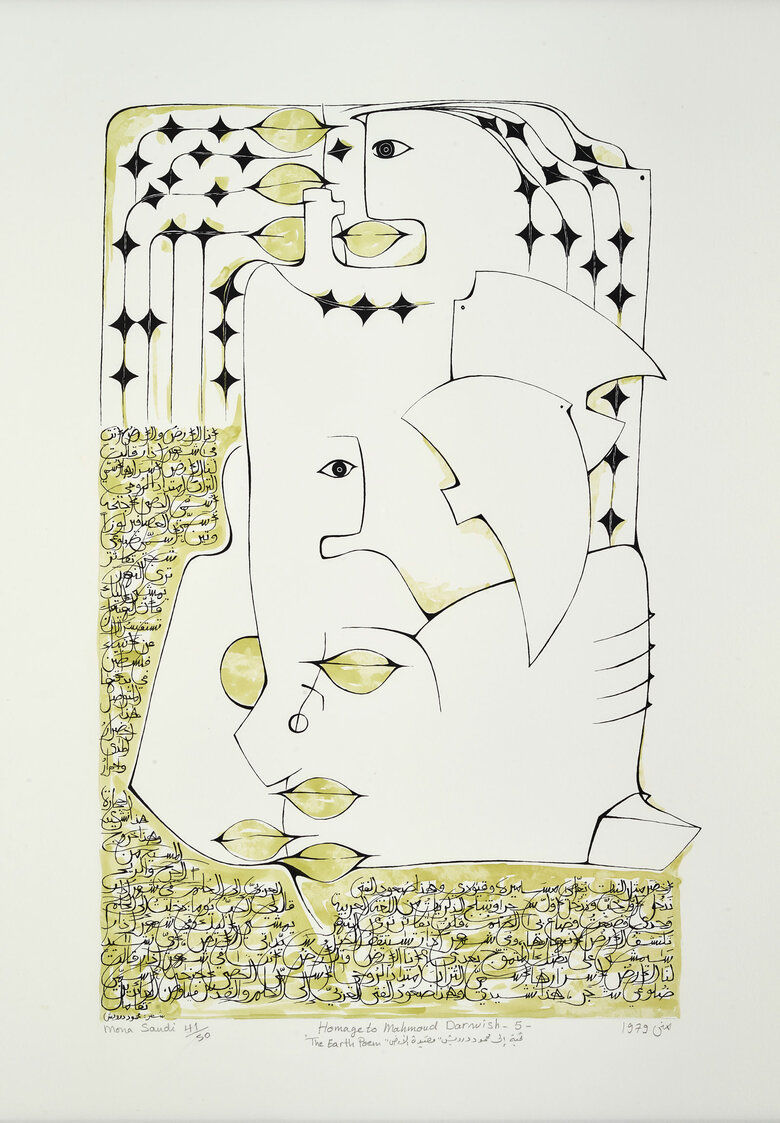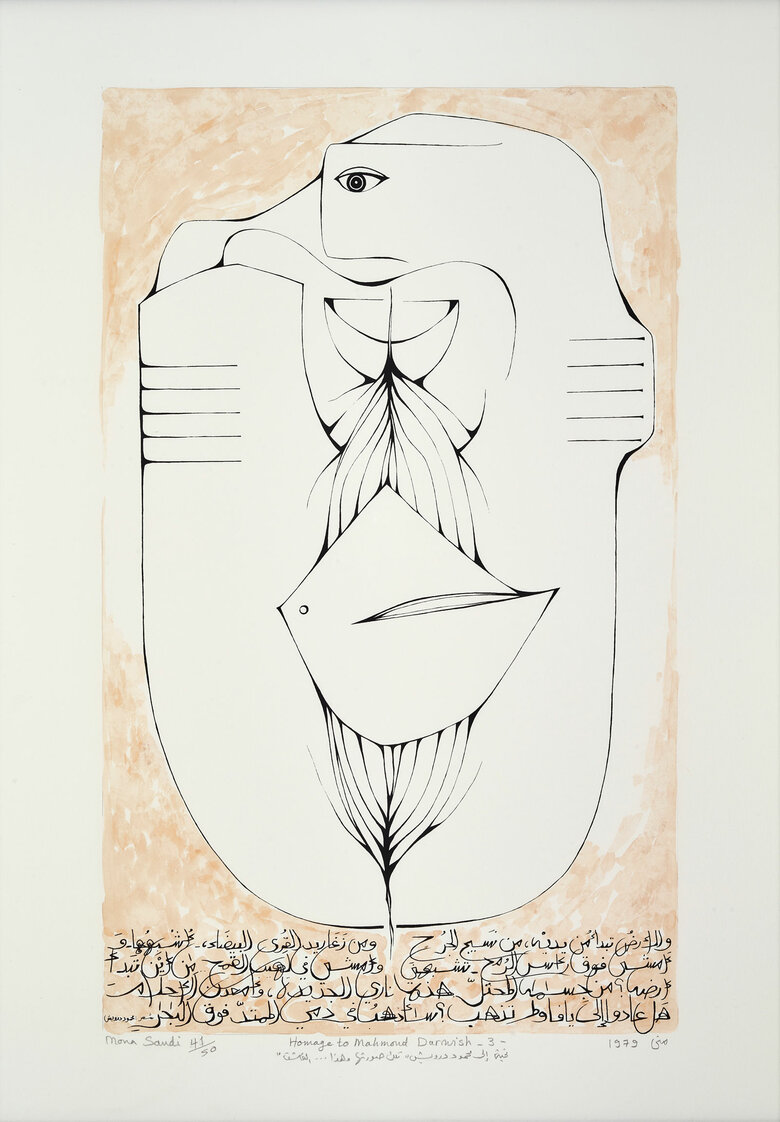Written by Mysa Kafil-Hussain For me making a sculpture is like creating poetry in stone. It comes from my inner self and every work I create is like a piece of my soulMona Saudi[1] Considered a...
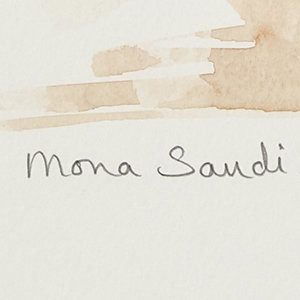

MONA SAUDI, Jordan (1945 - 2022)
Bio
Written by Mysa Kafil-Hussain
For me making a sculpture is like creating poetry in stone. It comes from my inner self and every work I create is like a piece of my soul
Mona Saudi[1]
Considered a pioneer of Jordanian art and a trailblazing female Arab Sculptor, Mona Saudi has been pushing boundaries throughout her successful artistic career and also throughout her personal life. Born in 1945 in Amman, into a strict and religious household, Saudi had been a dreamer from a young age, dreaming well beyond the confines of the limitations of her traditional upbringing. As a child, she would explore the ancient ruins surrounding her home which dated back millennia. Leaving her friends behind to play with stone statues and Roman columns, Saudi wondered how they were made and how the stone came to life.[2] She knew as a child that she wanted to be creative and to make art, feeling more at home in nature than anywhere else. “My first feelings were toward being earthy”,[3] explained Saudi in a 2010 interview, and these feelings drew her to the freedom of the outside world in many different ways. One of Saudi’s older brothers died when she was just eight years old, forcing her to reflect on how short life could be, and that there was no time to waste and no permission to seek: “I believe that rather than talking about dreams, one has to dare to act”.[4] At the age of seventeen, Saudi was forbidden by her father from applying to university, forcing her to make the decision to drop out of high school and, without permission from her family, fled from Amman to Beirut alone to pursue her dreams of becoming an artist.[5]
Saudi arrived in bustling Beirut in 1963, quickly feeling at home in the cosmopolitan Lebanese capital, and made lifelong friendships with poets, artists and writers, including Adonis, Paul Guiragossian and Youssef Al Khal.[6] Sculptor Michel Basbous took her under his wing, teaching the young artist all he knew about the artform, along with artist Halim Jurdak, who opened the doors for Saudi to Beirut’s burgeoning cultural scene.[7] This paved the way for Saudi’s first exhibition of her paintings in the building belonging to the Lebanese newspaper al-Nahar in the Hamra district, at the Café de la Presse. With the money made from works sold at the exhibition, Saudi financed her ticket to Paris, a city she had always dreamed of visiting. Travelling by sea, she arrived in Paris in February 1964 and ventured to find the only person she knew in the city – Halim Jurdak, who she had met in Beirut.[8] Jurdak helped Saudi find a place to stay, and she soon began studying sculpture at l’École Nationale Superieure des Beaux-Arts and exploring the Louvre and discovering the work of modern artists such as Constantin Branusci, whose sculptures left a lasting impression on her.[9] During this time, she also joined the Atelier Colamarini, where she learnt about carving, and also travelled to Carrara in Italy (famous for its marble quarries) where she spent several months in the city’s sculpture studios.[10]
In 1965, Saudi created her first work in stone, entitled Mother/Earth, a distinct limestone form exuding female energy. The title would be used many times over many decades in a series celebrating ideas of fertility and growth.[11] Saudi left Paris in 1968, briefly returning to Jordan to work in a Palestinian refugee camp following the June War, during which time she encouraged refugee children to express themselves by drawing, eventually compiling their work into a book entitled In Time of War: Children Testify. She then moved back to Beirut in 1969, where she began to experiment further and find her own, personal artistic style.
Following her time spent in the refugee camps, Saudi created more work related to the Palestinian cause in the following years. In 1968, she took part in the landmark ‘International Art Exhibition for Palestine’ at the Beirut Arab University, and once she moved back to Beirut, joined the Palestinian Liberation Organisation (PLO) art department, designing posters for the cause. Saudi was not just an artist – she was also a poet, and as well as creating work based on her own poetry (and publishing poetry collections) she began producing prints inspired by the words of others, including Adonis, which she exhibited during the Lebanese Civil War in 1975. She then undertook a project dedicated to her close friend, the Palestinian writer and poet Mahmoud Darwish, creating silkscreen prints inspired by and incorporating his poetry, seven of which (one full edition) can be found in the Dalloul Collection. In her homage to Darwish, she created The Lover’s Tree (1977), Song to the Green (1977), Poem of the Land (1979), The Earth Poem (1979), Poem of the Sand (1979), and This is Her Photograph and this is…the Lover (1979 and 1980), all large prints combining Darwish’s words written by Saudi’s hands, and drawings clearly relating to her natural and figural sculptural forms. The first – The Lover’s Tree – was inspired by Darwish’s long and moving poem he penned after his friend, the poet Rashid Hussein, took his own life. Saudi read the poem and drew a figurative image of two people embracing. Flanked above and below by rocks and a crescent form, Saudi sees this image as representing a love between human and land, an intimate relationship which can be seen in a multitude of ways throughout her sculptural drawings. Saudi later gifted this print to Darwish directly.[12]
Saudi related poetry, drawing and sculpture together as one, not only through incorporating poems into her drawings, but also seeing sculpting itself as a form of poetry: “When you write poetry, the first sentence comes and then the rest just starts to flow. It is the same with my sculpture.”[13] She would sculpt her works with her bare hands, forming a range of shapes and then transforming them into lyrical, rhythmic abstract forms, both intricately geometric and organically rooted at the same time. Her choice of material plays an important role in her work, having fallen in love with stone in the 1960s and becoming fascinated by the textures and colors found across the Arab world, including Syrian black diorite, a honey-colored Lebanese marble, Yemeni alabaster, and a green-veined marble from the deserts of Jordan, which she then dubbed ‘Jordanian jade’,[14] as well as white marble from Carrera. This range of textured marble, contrasting color and intimate manipulation of form can be seen in both Tree of Life and Birth of Beirut, both undated sculptures in the Dalloul Collection which exude a natural connection with the earth and body.
Saudi was persuaded to leave Beirut for Amman in 1983 in the midst of the civil war, and there continued her art practice in addition to illustrating books for a range of authors, including the late Ghassan Kanafani. Throughout the 1980s and 1990s she gained further success with important sculptural works installed in Paris’ Institut du Monde Arabe, the French Embassy in Amman and later won Jordan’s National Honorary Award from King Hussein in 1993.[15] Saudi soon returned to Lebanon, and several years later began working at the American University of Beirut (AUB), where she taught for roughly a decade whilst also participating in many exhibitions. Now jumping between Beirut, Amman and London, where her daughter (artist and designer Dia Batal) lives, Saudi continues to make art and exhibit. Seeing herself as a dreamer, inspired by beauty and harmony, Saudi is receptive to all influences, senses and events happening around her, which consistently feed into her work. Above all, however, she has always been inspired by nature, from her childhood until the present day, a “lady of the earth”.[16]
[1] Jyoti Kalsi, “Mona Saudi Creates Poetry in Stone”, Gulf News, June 24, 2015, https://gulfnews.com/entertainment/arts-culture/mona-saudi-creates-poetry-in-stone-1.1540044
[2] Farouk Yousif, “منى السعودي النحاتة التي أنطقت الحجر شعرا”, Al-Arab, February 21, 2016, http://alarab.co.uk/منى-السعودي-النحاتة-التي-أنطقت-الحجر-شعرا
[3] Matthew Teller, “Finding the Essence”, Aramco World, May/June 2010, https://archive.aramcoworld.com/issue/201003/finding.the.essence.htm
[4] Kalsi, “Mona Saudi Creates Poetry in Stone”
[5] Teller, “Finding the Essence”
[6] Barjeel Art Foundation & Abu Dhabi Music & Arts Foundation, “Mona Saudi”, Sky Over The East
Works from the Collection of Barjeel Art Foundation (Exhibition Catalogue), 2014, p.92, https://www.barjeelartfoundation.org/wp-content/uploads/2014/05/ADMAF_Barjeel_book-LR.pdf
[7] Yousif, “منى السعودي النحاتة التي أنطقت الحجر شعرا”
[8] Teller, “Finding the Essence”
[9] Yousif, “منى السعودي النحاتة التي أنطقت الحجر شعرا”
[10] Barjeel Art Foundation & Abu Dhabi Music & Arts Foundation, “Mona Saudi”, p.92
[11] XVA Gallery, “Mona Saudi”, XVA Gallery, Dubai, n.d., https://www.xvagallery.com/artist/mona-saudi/
[12] Arab News, “The Breakdown: Mona Saudi – ‘The Lover’s Tree’”, Arab News: Lifestyle, August 7, 2020, https://www.arabnews.com/node/1715906/lifestyle
[13] Ibid
[14] Teller, “Finding the Essence”
[15] Ibid
[16] Teller, “Finding the Essence”
Sources
Arab News: “The Breakdown: Mona Saudi – ‘The Lover’s Tree’”. Arab News: Lifestyle. August 7, 2020. Accessed September 2020. https://www.arabnews.com/node/1715906/lifestyle
Barjeel Art Foundation & Abu Dhabi Music & Arts Foundation. “Mona Saudi”. Sky Over The East
Works from the Collection of Barjeel Art Foundation (Exhibition Catalogue). 2014. p.92. Accessed September 2020. https://www.barjeelartfoundation.org/wp-content/uploads/2014/05/ADMAF_Barjeel_book-LR.pdf
Kalsi, Jyoti. “Mona Saudi Creates Poetry in Stone”. Gulf News. June 24, 2015. Accessed September 2020. https://gulfnews.com/entertainment/arts-culture/mona-saudi-creates-poetry-in-stone-1.1540044
Teller, Matthew. “Finding the Essence”. Aramco World. May/June 2010. Accessed September 2020. https://archive.aramcoworld.com/issue/201003/finding.the.essence.htm
XVA Gallery: “Mona Saudi”. XVA Gallery, Dubai. Accessed September 2020. https://www.xvagallery.com/artist/mona-saudi/
Yousif, Farouk. “منى السعودي النحاتة التي أنطقت الحجر شعرا”. Al-Arab. February 21, 2016. Accessed September 2020. http://alarab.co.uk/منى-السعودي-النحاتة-التي-أنطقت-الحجر-شعرا
CV
Selected Solo Exhibitions
2019
Poetic Inspirations, XVA Gallery, Dubai, United Arab Emirates
2018
Poetry and Form, Sharjah Art Museum, Sharjah, United Arab Emirates
Focus: Icons – Mona Saudi, Abu Dhabi Art (with Lawrie Shabibi Gallery), Abu Dhabi, United Arab Emirates
2017
Humanized Abstraction, Saleh Barakat Gallery, Beirut, Lebanon
2015
Poetry in Stone, Lawrie Shabibi Gallery, Dubai, United Arab Emirates
2012
Artcircle Gallery, Beirut, Lebanon
2011
Saint John Perse Foundation, Aix-en-Provenance, France
Europia Gallery, Paris, France
2010
Mona Saudi: Poetic Inspirations, The Mosaic Rooms, London, United Kingdom
Jacaranda Images Gallery, Amman, Jordan
2004
Quartier des Arts, Beirut, Lebanon
1999
Al Oudaya Museum, Rabat, Morocco
1995
Retrospective: Mona Saudi, Darat Al Funun, Amman, Jordan
1992
Galerie 50 x 70, Beirut, Lebanon
1985
Al-Salmieh Gallery, Kuwait City, Kuwait
1984
Alif Gallery, Washington D.C., United States of America
1983
Alia Art Gallery, Amman, Jordan
1982
Galerie Epreuve d’Artiste, Beirut, Lebanon
1981
Sculptures and Drawings, Galerie Elissar, Beirut, Lebanon
1975
Galerie Contemporaine, Beirut, Lebanon
1973
Galerie One, Beirut, Lebanon
1971
Galerie Vercamer, Paris, France
1963
Café de la Presse, Beirut, Lebanon
Selected Group Exhibitions
2025
Nadia Saikali & Her Contemporaries, Barjeel Art Foundation, Sharjah, United Arab Emirates
2024
Beyond Form: Lines Of Abstraction, 1950 - 1970, Turner Contemporary, Margate, UK
Of Friendships: Krishna Reddy & His World, Experimenter, Colaba, Mumbai, India
Arab Presences: Modern Art And Decolonisation: Paris 1908-1988, Musée d'Art Moderne de Paris, Paris, France
Of Friendships: Krishna Reddy & His World, Experimenter, Ballygunge Place, Kolkata, India
Impression on Stone, Tehran Museum of Contemporary Art (TMoCA),Tehran, Iran
2023
Beirut And The Golden Sixties: A Manifesto Of Fragility, Mathaf, Arab Museum of Modern Art, Doha, Qatar
In the Heart of Another Country: The Diasporic Imagination Rises, Sharjah Art Foundation, Sharjah, United Arab Emirates
In The Eyes Of Our Present, We Hear Palestine, Sharjah Art Foundation, Sharjah, United Arab Emirates
2022
Manifesto of Fragility: Beirut and The Golden Sixties, Lyon Museum of Contemporary Art, Lyon, France
Feared and Revered, National Museum of Australia, Canberra, Australia
2021
Upsurge: Waves, Colour and Illusions, Lawrie Shabibi, Dubai, United Arab Emirates
Cities Under Quarantine: The Mailbox Project, Villa Romana, Florence, Italy
Leads & Artistic Cues from the Arab World, Dalloul Art foundation (DAF), Beirut, Lebanon
2019
Out of Context, Saleh Barakat Gallery, Beirut, Lebanon
LINE, Darat Al Funun, Amman, Jordan
Materialize, Lawrie Shabibi, Dubai, United Arab Emirates
2017
Lines of Subjectivity: Portraits and Landscape Paintings, Jordan National Gallery of Fine Arts, Amman, Jordan
2015
Rituals of Signs and Transitions (1975-1995), Darat Al Funun, Amman, Jordan
2014
Sky Over the East, Emirates Palace, Abu Dhabi, United Arab Emirates
Poetry and Exile, The British Museum, London, United Kingdom
2013
Joint exhibition with Dia Batal, Jacaranda Images Gallery, Amman, Jordan
HIWAR: Conversations in Amman, Darat Al Funun, Amman, Jordan
2012
Le Corps Decouvert, Institut du Monde Arabe, Paris, France
The Power of Words: Artists from the Khalid Shoman Collection, Darat Al Funun, Amman, Jordan
2011
Salon d’Automne, Sursock Museum, Beirut, Lebanon
2007
Art Inspired by Poetry: Artists Inspired by the Khalid Shoman Collection, Darat Al Funun, Amman, Jordan
2004
Arabic Calligraphy: Contemporary Arab Artists, Darat Al Funun, Amman, Jordan
2003
International Cairo Biennale, Cairo, Egypt
The Khalid Shoman Collection, Darat Al Funun, Amman, Jordan
2001
Les Ateliers Arabes, UNESCO, Beirut, Lebanon
2000
Journey through the Contemporary Arts of the Arab World – Bilad Al Sham (1): Jordan, Darat Al Funun, Amman, Jordan
1997
Voyage en Jordanie, Hotel de Ville, Paris, France
1996
Rhythm and Form: Visual Reflections on Poetry, United States of America
1994
Forces of Change, National Museum of Women in the Arts, Washington D.C., United States of America
1993
Salon d’Automne, Sursock Museum, Beirut, Lebanon
1987
Arab Contemporary Artists, Institut du Monde Arabe, Paris, France
1981
Arab Artists, Kunst Hus, Oslo, Norway
1980
Palestinian Art, Tehran, Iran; Berlin, Germany; Warsaw, Poland
1979
Palestinian Art, Oriental Museum, Moscow, Russia
1978
International Art Exhibition for Palestine, Beirut, Lebanon
Colamarini and his Students, Musee Rodin, Paris, France
Palestinian Art, Tokyo, Japan
1972
Salon de Mai, Musée d’Art Moderne, Paris, France
Public Exhibitions
2018
Art Dubai (with Agial Art Gallery), Dubai, United Arab Emirates
2017
Beirut Art Fair (with Agial Art Gallery), Beirut, Lebanon
2016
Abu Dhabi Art (with Lawrie Shabibi Gallery), Abu Dhabi, United Arab Emirates
2015
Art Dubai (with Lawrie Shabibi Gallery), Dubai, United Arab Emirates
2014
Abu Dhabi Art (with Lawrie Shabibi Gallery), Abu Dhabi, United Arab Emirates
Collections
Asilah Museum, Morocco
Arab Bank Headquarters, Amman, Jordan
Barjeel Art Foundation, Sharjah, United Arab Emirates
The British Museum, London, United Kingdom
Cairo Bank Headquarters, Amman, Jordan
Dar Al Athar Al Islamiyya, Kuwait
Darat Al Funun: The Khalid Shoman Foundation, Amman, Jordan
French Embassy, Amman, Jordan
Al Hariri Art Collection, Beirut, Lebanon
Institut du Monde Arabe, Paris, France
International Sculpture Park, Rashana, Lebanon
Jabal Amman, Public Square, Amman, Jordan
Jordan National Gallery of the Fine Arts, Amman, Jordan
Ministry of Culture, Cairo, Egypt
Museum of Modern Art, Kuwait
National Museum for Women in the Arts, Washington D. C., United States of America
Ramzi and Saeda Dalloul Art Foundation, Beirut, Lebanon
Sharjah Art Foundation, Sharjah, United Arab Emirates
Sursock Museum, Beirut, Lebanon
University of Science & Technology, Irbid, Jordan
Al Wafa Bank, Casablanca, Morocco
Press
Mona Saudi, vingt ans de labeur et de liberté - Danny MALLAT - L_Orient-Le Jour.pdf
Al Jazeera.pdf
Mona Saudi - Darat al FununDarat al Funun.pdf
MonaSaudi_Poetry in Stone_Press_2017.pdf
منى السعودي_ أحفر أحلامي من خلال النحت.pdf
طباعة - منى السعودي في ليل امرئ القيس الطويل.pdf
منى السعودي.. علاقة جدلية بين الشِعر والحجر - الإمارات اليوم.pdf
منى السعودي_ رسوم درويشية.pdf
Mona Saudi’s Poetry in Stone exhibition is the sculptor’s first solo show in the region since the 1980s - The National.pdf
منى السعودي نحاتة شاعرة تبثّ الدفء في الحجر THAQAFIAT.pdf
MonaSaudi_PoeticInspirations_Press_2010.pdf
منى السعـودي .. جماليات الظل والنور.pdf
Al Rai P039.pdf
ArtAsiaPacific_ Poetry In Stone.pdf
Mona Saudi Sculptures and Works on Paper 1995-2017 SELECTIONS.pdf
منى السعودي_ الرسم شعراً.pdf
الحياة - منى السعودي تجسد شموس الشعراء.pdf
Mona Saudi-Poetic Inspirations - Exhibition at The Mosaic Rooms in London.pdf
منى السعودي_ عن العزلة والتخلّي وسفر الداخل.pdf
النحاتة منى السعودي.. الحجر إذ ينشد بالشعر والقصائد - موقع بيت الثقافة والفنون.pdf
منى السعودي... كائنات «مسكونة بالقصيدة».pdf
Mona Saudi_Et le poète encore est parmi nous... Hommage à Saint_John Perse_Press .pdf
الفنانة منى السعودي وابنتها المصممة ضياء البطل توجهان ‘تحية إلى محمود درويش’ بمعرض مشترك أول يحتضنه غاز_ » Print القدس العربي Alquds Newspaper.pdf
منى السعودي.pdf
هدية منى السعودي الى فرنسا_ منحوتة في السفارة الفرنسية في عمان.pdf
MonaSaudi_Aramco World_ Finding the Essence_Press.pdf
Al Arab p10.pdf
SAM_4251.pdf
منى السعودي ثلاثون عاما من الحجارة – مجلة نزوى.pdf
Mona Saudi - Alia Art Gallery — Center for Palestine Studies Columbia University.pdf
Jordanian Artist Mona Saudi Makes Lasting Art from Stone - BarakaBits.pdf
حدائق الحجر.. الفنانة منى السعودي خيارات في البعد النحتي.pdf
Fertility, Love, Maternity & Growth_ Mona Saudi at Saleh Barakat Gallery, Beirut BLOUIN ARTINFO.pdf
THE BREAKDOWN Mona Saudi — “The Lover’s Tree”.pdf
سعورس _ منحوتات منى السعودي ولوحاتها.pdf
Jordanian artist and sculptor Mona Saudi dies at 76.pdf
Jordanian Artist and Sculptor Mona Saudi Has Died at Age 76.pdf
المدن - منى السعودي... الحب الخصوبة والأرض في بيروت.pdf
صحيفة اليوم _ الفنانة منى السعودي توقع «أربعون عاما في النحت».pdf
منى السعودي_ «أحيا لأنحت وأنحت لأحيا» Laha Magazine.pdf
MonaSaudi_AWomanWithoutComplexes_Press.pdf
Selections_Mag_44_LR_p2_Sharjah Art Museum.pdf
حوار ڤوغ العربيّة مع النحّاتة الأردنية منى السعودي ڤوغ العربيّة.pdf
MonaSaudi_Inspirations poétiques_Press.pdf
منى السعـودي .. جماليات الظل والنور.pdf
منى السعودي_ عن العزلة والتخلّي وسفر الداخل.pdf
إبداعات نسائية تشكيلية فلسطينية - ديوان العرب.pdf
Gallery_Summer 2019_Issue 4_Oussama Baalbaki_Ginane Makki Bacho_Samir Sayegh_Mona Saudi_Tagreed Darghouth_Anachar Basbous.pdf
Sotheby’s and Dubai galleries partner to raise money for UNHCR COVID-19 fund.pdf
MONA SAUDI Artwork
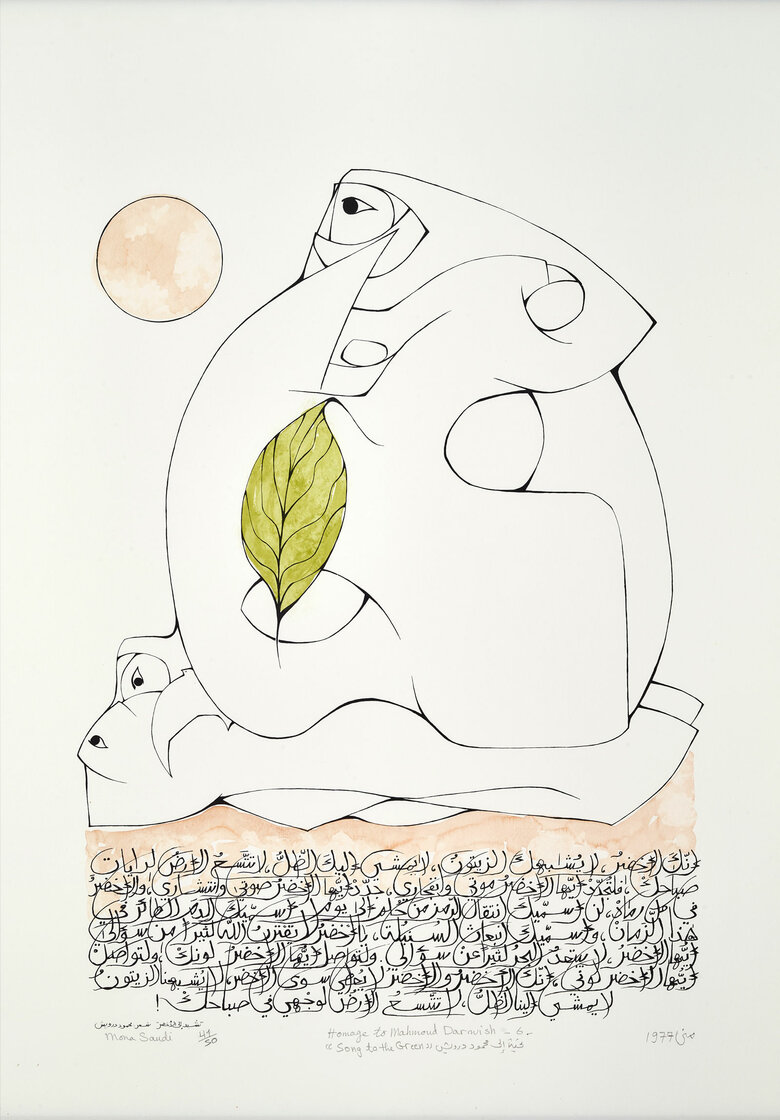

تحية لمحمود درويش - نُشيد إلى الأخضر Homage to Mahmoud Darwish: Song to the Green
MONA SAUDI, Jordan, 1977
82.5 x 54 cm
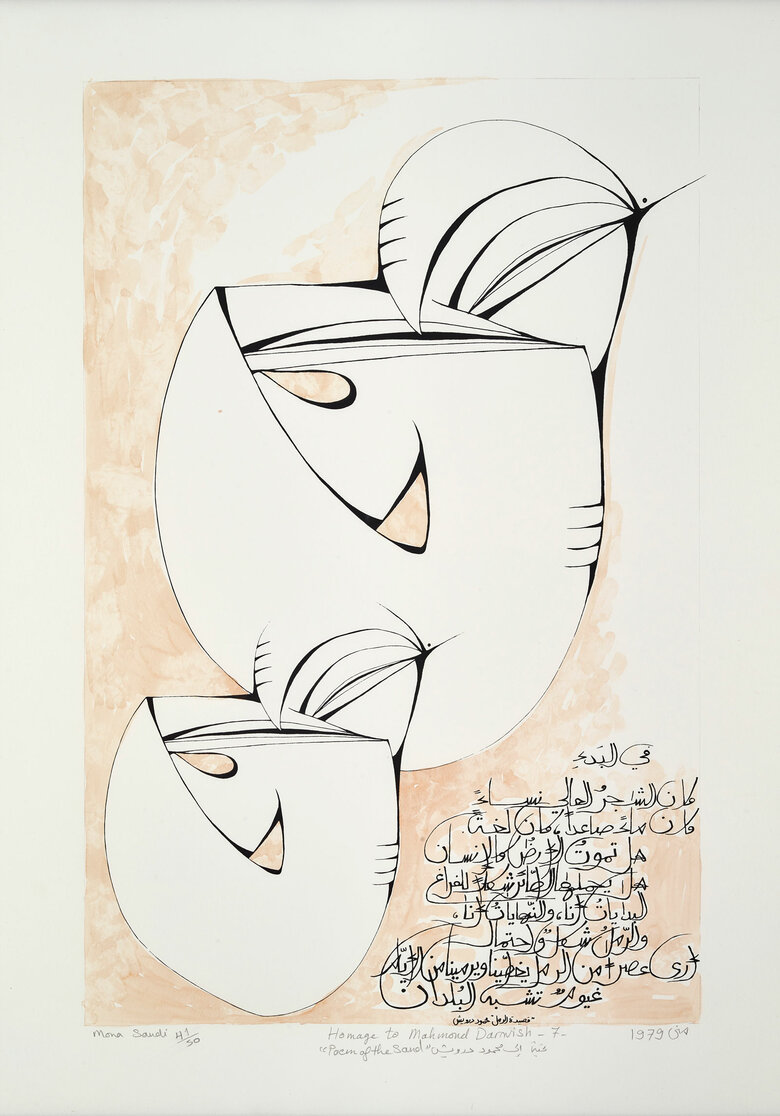

Homage to Mahmoud Darwish-7- "Poem of the sand"/ تحية لمحمود درويش
MONA SAUDI, Jordan, 1979
82.5 x 54 cm
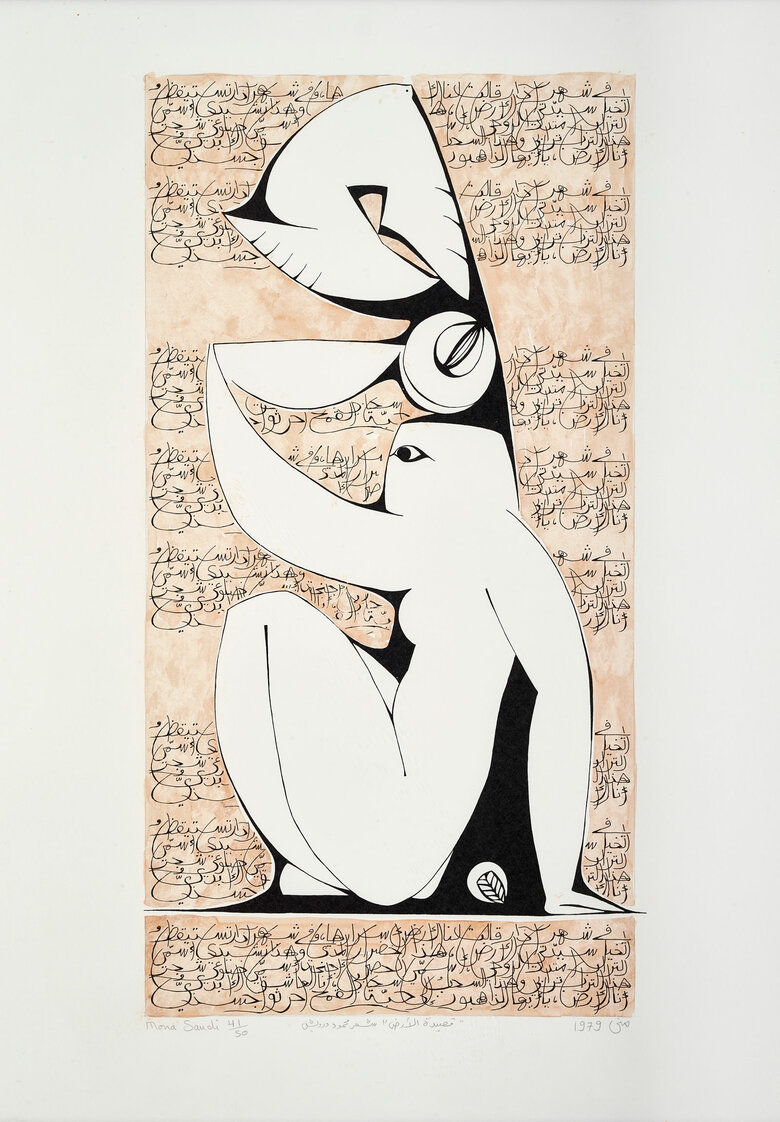

تحية لمحمود درويش - قصيدة الرمل Homage to Mahmoud Darwish: Poem of the Sand
MONA SAUDI, Jordan, 1979
82.5 x 43 cm

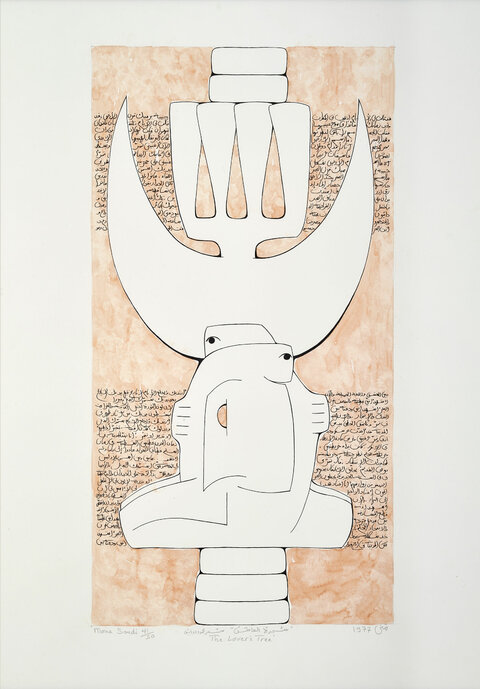
تحية لمحمود درويش - شجرة العاًشق Homage to Mahmoud Darwish: The Lover’s Tree
MONA SAUDI, Jordan, 1977
82.5 x 43 cm
Become a Member
Join us in our endless discovery of modern and contemporary Arab art
Become a Member
Get updates from DAF
Follow Artists
Save your favourite Artworks
Share your perspectives on Artworks
Be part of our community
It's Free!
We value your privacy
TermsCookiesPrivacy Policies
Become a Member
Get updates from DAF
Follow Artists
Save your favourite Artworks
Share your perspectives on Artworks
Be part of our community
It's Free!
We value your privacy
TermsCookiesPrivacy Policies
Become a Member
Get updates from DAF
Follow Artists
Save your favourite Artworks
Share your perspectives on Artworks
Be part of our community
It's Free!
We value your privacy
TermsCookiesPrivacy Policies
Welcome to the Dalloul Art Foundation
Thank you for joining our community
If you have entered your email to become a member of the Dalloul Art Foundation, please click the button below to confirm your email and agree to our Terms, Cookie & Privacy policies.
We value your privacy, see how
Become a Member
Get updates from DAF
Follow Artists
Save your favourite Artworks
Share your perspectives on Artworks
Be part of our community
It's Free!
We value your privacy
TermsCookiesPrivacy Policies


